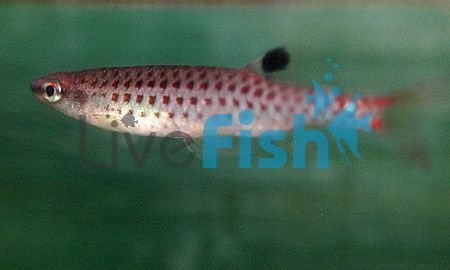Splashing Tetra 3cm
Copella Arnoldi
a
$30.58
Availability:
Out of stock
SKU
TW680030
- Buy 5 for $24.46 each and save 20%
- Buy 10 for $21.41 each and save 30%
Splashing Tetras are given this name due to there unique breeding technique. The male and the female will jump out of the water and attach themselves to vegetation within reach of there jump. Then release the eggs, and drop back down into the water. They will repeat this process until around 300 eggs are laid. After this, the male will continue splashing the eggs with his tail to stop them drying out. This continues for a couple days until the fry hatch and fall into the water.
Tetras are considered easy to keep in a community aquarium of at least 20L, with a pH of 5.07.0 and KH of 1.02.0. However, they will not tolerate dramatic changes to their environment. The Tetra can live 10 years or more with the proper conditions. They tend to be timid and, because of their small size, should not be kept with large or aggressive fish who may bully or simply eat them.
Fish that mix well in an aquarium are other types of tetras, and other community fish that live well in an ideal Tetra water condition. Mid-level feeders, they are best kept in schools of five to eight or more, for the "shoaling" effect when they move around the tank. They shoal naturally in the wild and are thus happier, more brightly coloured, and more active when kept as a shoal as opposed to singly.
Tetras are best kept in a densely planted tank with subdued light and an ideal temperature of 2024?C to resemble their native Amazon environment. Tetras are omnivores and will accept most flake foods, but should also have some small foods such as brine shrimp, daphnia, freeze-dried bloodworms, tubifex, and micro pellet food to supplement their diet.
Fish that mix well in an aquarium are other types of tetras, and other community fish that live well in an ideal Tetra water condition. Mid-level feeders, they are best kept in schools of five to eight or more, for the "shoaling" effect when they move around the tank. They shoal naturally in the wild and are thus happier, more brightly coloured, and more active when kept as a shoal as opposed to singly.
Tetras are best kept in a densely planted tank with subdued light and an ideal temperature of 2024?C to resemble their native Amazon environment. Tetras are omnivores and will accept most flake foods, but should also have some small foods such as brine shrimp, daphnia, freeze-dried bloodworms, tubifex, and micro pellet food to supplement their diet.
| Scientific Name | Copella Arnoldi |
|---|
Write Your Own Review




